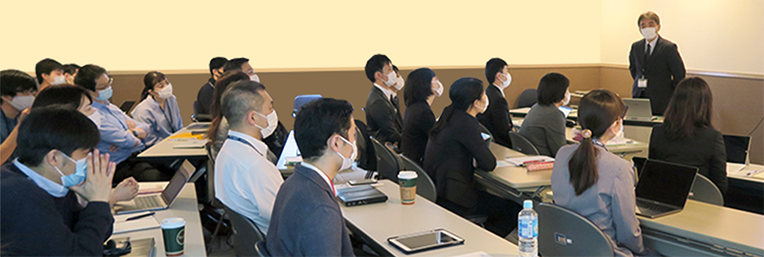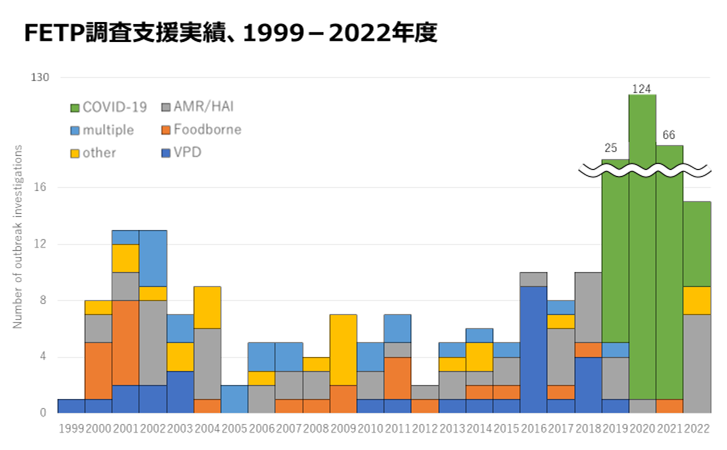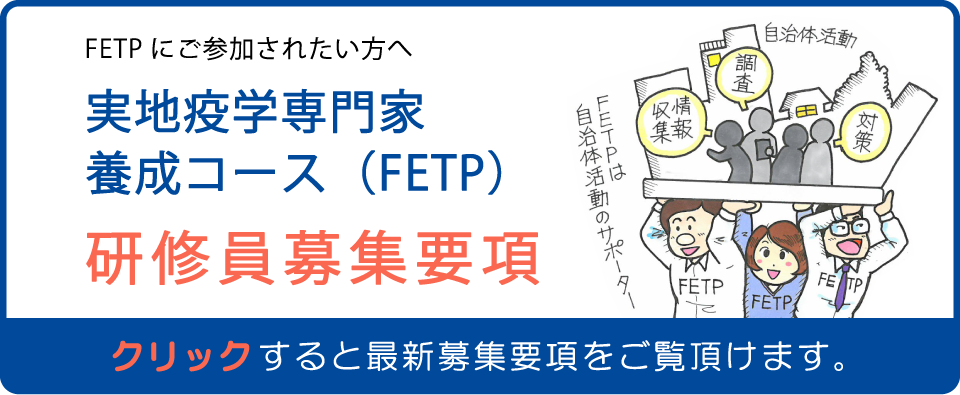お知らせ
感染症情報
研究・検査・病原体管理
サーベイランス
刊行・マニュアル・基準
- 詳細
FETP-J
実地疫学専門家養成コース 感染症危機管理事例の実地疫学調査研修員募集

実地疫学専門家養成コース
Field Epidemiology Training Program Japan (FETP-J)
感染症危機管理事例(感染症アウトブレイク事例)の
実地疫学調査

2022年度
・新型コロナウイルス感染症クラスター対応 多数
・新型コロナウイルス感染症成人死亡例調査
・バンコマイシン耐性腸球菌感染症院内集積事例
・多剤耐性アシネトバクター感染症院内集積事例
・メチシリン耐性黄色ブドウ球菌感染症院内集積事例
・マスギャザリング対応支援
2021年度
・新型コロナウイルス感染症クラスター対応 多数
2020年度
・新型コロナウイルス感染症クラスター対応 多数
・カルバペネム耐性腸内細菌科細菌発生事例
2019年度
・新型コロナウイルス感染症クラスター対応 多数
・院内Salmonella Enteritidis感染症集積事例
・多剤耐性アシネトバクター属菌院内集積事例
・バンコマイシン耐性腸球菌院内集積事例
・メチシリン耐性黄色ブドウ球菌院内集積事例
2018年度
・麻疹アウトブレイク事例
・バンコマイシン耐性腸球菌院内感染事例
・細菌性赤痢アウトブレイク事例
・多剤耐性アシネトバクター属菌院内集積事例
・多剤耐性アシネトバクター属菌院内集積事例
・麻疹アウトブレイク事例
2017年度
・バンコマイシン耐性腸球菌院内感染事例
・カルバペネム耐性腸内細菌科細菌院内集積事例
・Salmonella Enteritidis感染症事例
・介護老人保健施設病原性大腸菌アウトブレイク事例
・園児死亡事例
また、国内の健康危機管理事例対応力強化のため、FETP研修生には研修参加、そして研修会の講師を行っていただきます。
・国立感染症研究所での初期導入コース(約1ヶ月間)
・感染症危機管理研修会(全国及び地方ブロックなど)
・地方衛生研究所サーベイランス業務従事者研修
・自治体からの依頼に基づく講演会・研修会

Field Epidemiology Training Program Japan (FETP-J)
- 詳細
実地疫学専門家養成コース
Field Epidemiology Training Program Japan (FETP-J)
実地疫学研究センター(実地疫学専門家養成コース:FETP を含む)の報告は、こちらにも掲載しております。ご覧ください。
感染症サーベイランス情報の解析・評価/活動報告
NEW
2024年3月29日
感染症サーベイランス情報の解析・評価
NEW
2024年3月12日
リスク評価
NEW
2024年1月6日
リスク評価
お知らせ
NEW
2024年3月6日
短期セミナーのお知らせ
Field Epidemiology Training Program Japan (FETP-J)
- 詳細
FETP-J
実地疫学専門家養成コース 関連リンク研修員募集

実地疫学専門家養成コース
Field Epidemiology Training Program Japan (FETP-J)

世界のFETP
刊行物
その他
Field Epidemiology Training Program Japan (FETP-J)
- 詳細
- 詳細
FETP-J
実地疫学専門家養成コース よくあるご質問研修員募集

実地疫学専門家養成コース
Field Epidemiology Training Program Japan (FETP-J)

大学院博士・修士課程に進むか、FETPに参加するか迷っています。
FETPでは特に何が学べますか?
FETPでは特に何が学べますか?
本コースは国際的な実地疫学専門家(Field Epidemiologist)の養成コースに準拠した厚生労働省の認定する研修です。
ここでは、集団食中毒事例対応、インフルエンザや麻疹などの市中感染事例対応、医療関連感染事例対応、エボラ出血熱や新型インフルエンザ等の新興再興感染症の対応準備を、国立感染症研究所職員の指導のもと、業務として責任を持っていただく形で学ぶことができます。
これは座学のみでは経験しがたい実地疫学を学べる環境です。
ここでは、集団食中毒事例対応、インフルエンザや麻疹などの市中感染事例対応、医療関連感染事例対応、エボラ出血熱や新型インフルエンザ等の新興再興感染症の対応準備を、国立感染症研究所職員の指導のもと、業務として責任を持っていただく形で学ぶことができます。
これは座学のみでは経験しがたい実地疫学を学べる環境です。
1
FETPは2年間と聞きましたが、その間どのように活動されるのでしょうか?
またその間の身分や処遇はどうなりますか?
またその間の身分や処遇はどうなりますか?
FETPで過ごす2年間は原則国立感染症研究所実地疫学研究センターにおいてフルタイムで業務を行います。身分や処遇は採用時の所属で大きく2つに分かれます。いずれの場合も、感染症危機管理事例発生時の実地疫学調査に係る費用及び疫学研究の経費は国立感染症研究所が負担します。
1. 国・自治体からの派遣の場合
自治体の身分・処遇を継続し、協力研修員として国立感染症研究所実地疫学研究センターで2年間の研修を受けることになります。研修2年目については、事前相談の上、派遣元自治体における研修も組み込むことができます。
2.国・自治体からの派遣以外の場合
国立感染症研究所任期付研修員としての身分を有し、給与の他、年2回の賞与、通勤手当、退職金(支給条件あり)が支給されます。
また、雇用、公災、健康、保健等各種保険への加入があります(加入条件あり)。
詳細については国立感染症研究所FETP室までお問合せ下さい。
1. 国・自治体からの派遣の場合
自治体の身分・処遇を継続し、協力研修員として国立感染症研究所実地疫学研究センターで2年間の研修を受けることになります。研修2年目については、事前相談の上、派遣元自治体における研修も組み込むことができます。
2.国・自治体からの派遣以外の場合
国立感染症研究所任期付研修員としての身分を有し、給与の他、年2回の賞与、通勤手当、退職金(支給条件あり)が支給されます。
また、雇用、公災、健康、保健等各種保険への加入があります(加入条件あり)。
詳細については国立感染症研究所FETP室までお問合せ下さい。
2
実務研修期間を短縮することは可能ですか?
原則2年間です。但し、FETP研修者以外の人でも初期導入コース(年度当初の1ヶ月間)は若干の見学・参加者を受け入れ可能でますので希望者はお申し込みください。
3
どのような経歴・職種の人が応募できますか?
医師、歯科医師、獣医師、薬剤師、保健師、看護師、検査技師、食品衛生監視員等の資格を有しており、原則として2年以上の臨床研修あるいは3年以上の公衆衛生活動に従事した経験を有する者が対象です。
4
実務研修修了者には学位が授与されますか?
学位の授与はありません。所定の研修事項を修得した方には、国立感染症研究所長、実地疫学研究センター長より修了証が授与されます。
5
国立感染症研究所(東京都)以外に活動拠点はありますか?
研修期間中は感染症研究所が活動拠点ですが、事例や状況により、短期間、地方自治体の保健部局、厚生労働省、国連機関(世界保健機関など)等で活動することがあります。
6
英語力はどの程度必要でしょうか?
実務研修の場は殆ど国内ですが、英語論文を多数読みこなせ、外国人を交えた会議でコミュニケーションできる英語力を持つことが望ましいです。
7
修了後はどのような活動が期待されていますか?
修了者は派遣元、あるいは新しい職場でFETPにおいて学んだ実地疫学の知識・経験を活用し、公衆衛生の向上のための仕事に従事しています。FETPネットワークの一端となって頂くことを期待しています。
8
今後の募集人員はどうなりますか?
指導スタッフ数や研修場所に制約があるため、募集人員は毎年数名です。毎年、11月頃に感染研サイトに翌年度の募集要項を掲載し、年明け1月中旬過ぎに募集開始となります。
応募可能期間が短いためスケジュールにはご注意下さい。
応募可能期間が短いためスケジュールにはご注意下さい。
9
【お問合せ先】
国立感染症研究所実地疫学研究センターFETP室
Tel:03-6261-5930 Fax:03-6261-5930
Email:q-fetp[at]nih.go.jp
※Emailは[at]をアットマークに変えご利用ください。
Field Epidemiology Training Program Japan (FETP-J)
- 詳細

2017年5月現在
1.感染症集団発生事例疫学調査(2015〜2016年度)
2.感染症サーベイランス解析・評価
3.感染症疫学研究の実施(2016年度FETP17期生の長期研究)
4.感染症疫学情報の発信
5.感染症疫学における教育経験
6.感染症疫学セミナー
7. 最近のFETPの主な論文発表業績(2015〜2016年度) 【2016年度】
【2015年度】
|




